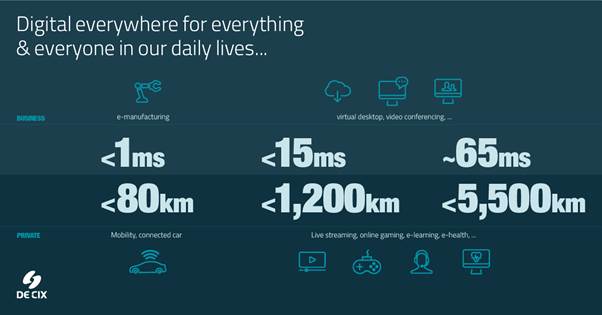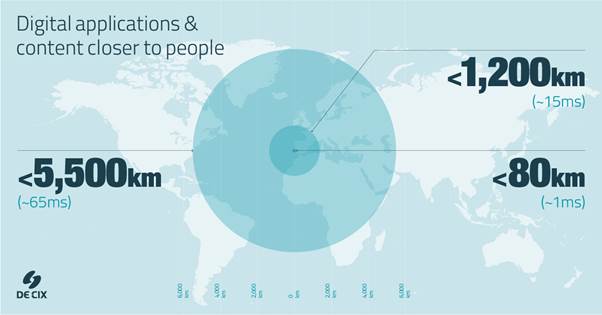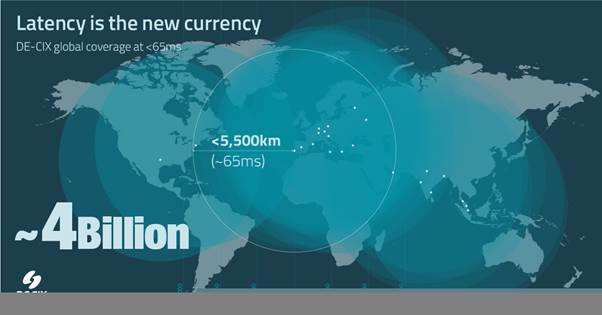By: Ivo Ivanov, CEO DE-CIX International
We are entering a new era of digitalization – a new era of interconnection – in which digital applications and services will be needed everywhere, for everyone. The year 2021 heralds the beginning of the most exciting digital decade since the original boom of the commercial Internet. Digital business has definitively become the backbone of economic growth for the future, and no sector can afford not to be on the path to digitalization. It’s no longer a question of whether you should digitalize. Yes, you should. The faster, the better.
All areas of business and private life rely more heavily today than ever before on digital applications. These have proven their worth in recent months, finding their place in our professional and personal lives. But beyond the virtual desktop and video streaming, specific sectors are also taking leaps ahead with digital applications and services, ranging from e-health to very sophisticated logistics and mobility applications, and on to the finance sector. This transformation has not been caused by the Covid-19 pandemic, but it has been accelerated by it. This accelerated pace of the digitalization of enterprises will become one of the key factors for future economic growth.
As economic activity moves from the analog to the digital sphere, there is one thing that all these applications have in common, and this is related to the purely physical characteristics of the speed of light. In the digital infrastructure industry, we call this “latency”.
Latency is the new currency
Latency has to do with reaction times – the time it takes data to be sent for processing or analysis and for a reaction to occur or a result to be visible. Put simply; this is what causes the lag we experience with pan-oceanic or long-distance video conferencing and calls. Latency is decisive for the time it takes for a transaction to be registered when you’re making online purchases; for getting a smooth reaction and good user experience when using applications that are hosted in the cloud; for the time between executing a maneuver in an online game and your counterpart experiencing the result. Latency is what allows you to enjoy high-definition online sports streaming in real time and reap the rewards of modern education in high-quality hybrid schooling.
And that’s only seen from the perspective of the user. From a business perspective, latency issues cost you money. Productivity related to virtual desktops, conference and video calls, and all that is entailed in working from home is dependent on high-performance interconnection. But also industrial activities like remote robotics, AI-supported research and development, and the advances in the product development of the connected car would not be conceivable without the performance, security, and resilience that comes with the lowest possible latency. So, latency in digital services and applications is truly revenue-related.

Latency – the lifeline in the digital world
However, latency-sensitivity goes deeper. It is not only a hallmark of quality and guarantee of productivity, but also a lifeline: the real-time responses needed for critical e-health applications; the time between sensors on a car recognizing a hazard and calculating evasive action or sending a warning signal to the driver; but also the minuscule reaction times needed for financial trading and sophisticated e-manufacturing systems.
Such critical applications, of course, have high requirements for both performance and resilience/security, elements that are also extremely closely related to latency. From a performance perspective, the applications need response times in the low millisecond range. They also require a very high level of resilience and security to ensure the seamless transmission of data. Critical applications also entail highly sensitive data – be that business secrets or personal health records – which needs to be secured in a safe environment.
All of this leads to one key lesson which will guide us into the future. When it comes to quality and infrastructure services, latency is the new currency.
The maximum latency you can afford to ensure a decent end-user experience with today’s general-use applications is around 65 milliseconds. To be honest though, a latency of no more than 20 milliseconds is necessary to perform all these daily activities with the level of performance that everybody deserves. Translating this into distance, this means the content and the applications need to be as close to the users as possible. Geographically speaking, applications like interactive online gaming and live streaming in HD/4K need to be less than 1,200 km from the user.
But the applications that our digital future will be based on will demand much lower latency – in the range of 1-3 milliseconds. Smart IoT applications, and critical applications requiring real-time responses, like autonomous driving, need to be performed within a range of 50-80 km from the user.

Being right on the spot – lowering latency and increasing resilience and security
At DE-CIX, we can offer enterprises both the lowest latency and the highest resilience and security. How do we do this? By bringing you directly together with the networks you need to share data with. When you connect to a DE-CIX Internet Exchange, you are right there, where the economy of the future is playing out. Companies need high-performance, secure interconnection in order to do business. In the digital world, resiliency is business-critical.
To guarantee continuity of service, DE-CIX offers enterprises interconnection solutions that connect directly to the required application or compute source – for example, to the many cloud services an enterprise makes use of (through DE-CIX DirectCLOUD), or to applications such as those available through Microsoft 365, with direct connectivity possible for enterprises via DE-CIX with the Microsoft Azure Peering Service. In this way, latency is minimized and resilience is ensured. But providing for the sector-specific interconnection needs of enterprises goes much deeper, as we shall see.
What do enterprises need from interconnection? Use case – mobility
When it comes to the interconnection needs of enterprises, the mobility sector is a clear trailblazer. The connected car is an ecosystem of data, entailing a huge variety of types of data. Examples include data relating to physical safety and the physical conditions on the road, data for improving traffic management, data on the status and maintenance of the car, entertainment, and so on.
The immense volume of car-related data can be divided into two main types: data in the car, and data outside of, or leaving, the car. 70 percent remains in the car and can be off-loaded in a quiet moment in the garage. But the other 30 percent is critical for safety and performance on the road and is extremely latency-sensitive. This data relates to the communication between cars (car2car), as well as with the cloud (car2cloud) and the environment (car2environment data – e.g., interaction with different sensors and signs on the road). This data requires high-performance, low-latency, and secure interconnection services between the different cars on the road, and between the networks of the car manufacturer, and all of these other data suppliers and receivers.
The old approach
The approach for automotive manufacturers in the past has been a best-effort solution involving MPLS and IP transit (upstream), with no end-to-end control of the traffic flows between the car and the networks that wish to deliver data to the car or receive data from the car. This creates performance challenges because the more intermediates between the two networks, the worse the performance is and the higher the latency is. This also creates security issues, such as DDoS attacks and IP hijacking, as well as compliance issues – because if you do not control the data value chain, you cannot control compliance.
Last but not least, if you consider the hundreds – potentially thousands – of organizations that want or need to deliver data into the car and receive data generated by the hundreds of sensors within the car, this results in a significant complexity issue. If a car company wants to interconnect with all these partners and suppliers, the result of the old approach is literally thousands of bilateral interconnections and relationships – something that nobody can efficiently manage.
The new approach – making the complexity disappear like magic
This can be solved using existing logic – the logic of interconnection as we have it in our DE-CIX ecosystems. Direct interconnection between the parties, using the very efficient principle of one-to-many or many-to-many, aggregating the traffic instead of using multiple bilaterals. It works like magic – the complexity simply disappears. We see one clean environment where the car network can interconnect with all the participants that want to deliver data to the car and receive data from the car, all in a single protected and highly efficient environment.
The ecosystems of DE-CIX are the natural home for such enterprise ecosystems. Today, we have 2,100+ connected networks across the globe, and these networks serve the finance industry, the automotive industry, the healthcare industry – they already participate in these value chains. That means they are already on the spot, within spitting distance – an enterprise can easily bring together all partners in one place, making interconnecting with them fast and easy, secure, resilient, and very low latency. Therefore, using the DE-CIX ecosystems to locate protected new stakeholder-specific ecosystems, with all the protection enterprises require and expect, is a natural step.
How enterprises can own and control interconnection
On the DE-CIX platform, an enterprise – in the use case above an automotive manufacturer, but the approach is independent of sector – can set up its own Closed User Group, dictating the policies they need fulfilled in terms of performance, security, compliance, etc. Within this environment, everything is protected, and, at the same time, very efficiently interconnected – capitalizing on the advantages of existing ecosystems, such as proximity of networks and therefore reduced latency. This solution provides an answer to how, in a closed environment, an enterprise network can interconnect with other networks, reducing the complexity, increasing the security, improving the performance, and creating manageable compliance.
Panning out from this concept, if several organizations within a sector – like automotive, finance, healthcare, etc. – decide to create a joint policy based on common needs and common regulatory requirements, they can create a federation by sector. The DE-CIX Enterprise Interconnection Federation is our concept for the industry world, for every single type of business, meeting their demand for accelerated digitalization, meeting their needs for enterprise services, as well as meeting the demand for their own services resulting from digital transformation around the world.

Digital everywhere, for everyone
The enterprise of the future is digital. Latency is the new currency for the exciting next generation of applications and services. This means that digital infrastructure will be even more important in the future, and these needs are universal in the modern world.
As latency requirements get lower and lower, it becomes more and more important to bring interconnection services as close to people and businesses as possible – everywhere. DE-CIX, the operator of the world’s leading interconnection ecosystems, brings low-latency, high-performance interconnection services to 25 Internet Exchanges around the world, connecting over 2100 of the world’s largest networks, available through 500+ data centers in more than 100 countries.
Today, with our IXs around the globe, we provide coverage for approximately 4 billion people at a latency of 65ms or lower. However, if latency requirements continue to develop in line with the speed of innovation that we have seen in recent years, within a relatively short time, digital services and applications will have advanced to the point that even lower latencies are required. For a seamless end-user experience, this is likely to reduce to a maximum of 20ms in the near future.
In such a context, the overlapping nature of our current interconnection coverage would be broken – and we will need to double the number of markets again. Therefore, we will need to enable even more markets, in increasing proximity, in the future. To provide low-latency coverage of everything for everyone, we will need significantly more platforms, in much greater density.
DE-CIX is preparing for that future – but this is another story, for another time: suffice to say that DE-CIX is and will remain the conduit bringing digital everywhere, for everyone.




